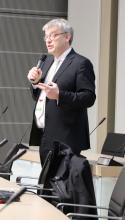Feed-a-Gene: 5 years of research
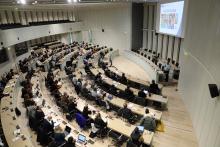
 Introduction
Introduction
Isabelle Pellerin, vice-president of Rennes Métropole, opened the conference by thanking the organizers for setting it up in Brittany, which is the first agricultural region of France.
“We need you”
In the first presentation of the plenary session, Jaap van Milgen gave the audience a brief overview of what the project did in the past five years: novel feeds for increasing protein autonomy in Europe; novel traits to observe variation; new traits and models for the genetic improvement of feed efficiency; new models of biological function for understanding and predicting animal response; precision feeding systems; a sustainability assessment of the solutions proposed by the project. Jaap van Milgen noted that the Technology Readiness Level of Feed-a-Gene innovations is between 3 (Research to prove feasibility) to 7 (Demonstration and development). It is up to stakeholders to take the proposed innovations and bring them to the market. The goal of the final conference was to ensure that the realisations of the project will have impact on society in the 5, 10 or 20 years to come.
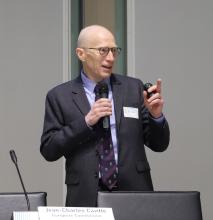 From Horizon 2020 to Horizon Europe
From Horizon 2020 to Horizon Europe
Jean-Charles Cavitte, Research Programme Officer at DG Agriculture and Rural Development, described the strategic approach to EU agriculture research & innovation. About 30 projects (200 M€) related to livestock production were funded under Horizon 2020. In the next programme Horizon Europe, 10 billion € are dedicated to the Cluster “Food, Bioeconomy, Natural Resources, Agriculture and Environment”. Among the priorities with short and medium term impact listed by the strategic planning for agriculture, the following are relevant to livestock:
- Climate- and environmentally-friendly practices in farming
- Diversity in farming
- Better-adapted animal breeds
- Resource use efficiency in agriculture
- Implementation and upscaling of agro-ecological approaches in primary production
- Prevent, monitor and control animal pests and diseases
- Improved animal health and welfare
- Sustainability-oriented redesign of food and non-food value chains
- Data, knowledge base and impact measurements
The Horizon Europe Work Programme 2021-2022 is being drafted and the first calls for 2021 are expected by the end of 2020.
Five years of research
Each Work Package leader presented the objectives of their work package and the results obtained at the end of the project.
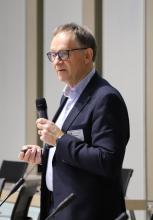 WP1: In search for European protein autonomy – more and better (Knud Erik Bach Knudsen, Aarhus University)
WP1: In search for European protein autonomy – more and better (Knud Erik Bach Knudsen, Aarhus University)
- European grown soybean: processes used in Feed-a-Gene involve extrusion or cooking with or without dehulling to produce expeller soybean meal with reduced content of antinutritional compounds and high protein and amino acids digestibility. These products were tested in pigs and broilers.
- Protein from green biomass: fractionation of green biomass into a protein concentrate rich in soluble protein with a higher protein and amino acids and a reduced content of antinutritional compounds. This concentrate has been tested with pigs. The fibrous pulp by-product was tested in rabbits.
- Improving the quality of rapeseed meal: tail-end separation resulted in a fine fraction with a higher protein and amino acids digestibility and less fibre and antinutritional compounds. This fraction was tested in pigs. Rapeseed meals processed with or without enzymes were tested in poultry and pigs.
- Real-time evaluation of nutritive value: calibration equations from NIR scans based on in vivo data were developed, as well as equations for macronutrients, amino acids, total tract digestibility of energy and nutrients and metabolizable energy in pigs.
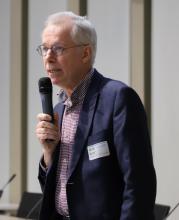 WP2: New animal traits for innovative livestock management strategies (Alfons Jansman, Wageningen Livestock Research)
WP2: New animal traits for innovative livestock management strategies (Alfons Jansman, Wageningen Livestock Research)
Novel methodologies and numerous traits have been investigated:
- Measurements of individual feed intake in broilers and rabbits.
- NIRS determination in faeces for the rapid evaluation of variation in nutrient digestibility between pigs.
- Faecal microbiota composition as a trait to differentiate low and high feed efficiency pigs.
- Birth weight and breeding value for protein deposition and N-efficiency in growing pigs.
- Physical activity on heat production in sows.
- Microbiota and heat stress in pigs.
- Biomarkers in serum for AMEn in broilers.
- Predictive biomarkers in muscle tissue and blood in pigs.
- Managing variation among individuals through precision livestock feeding.
Further understanding of responses of animals to feed and nutrient intake requires simultaneous measurement of data and information on the genotype, phenotype and the environment.
New traits have been identified related to feed and nutrient efficiency in pigs, poultry and rabbits which can be used in new precision feeding concepts and future breeding programmes. However, validation of the use of the traits and biomarkers requires further attention.
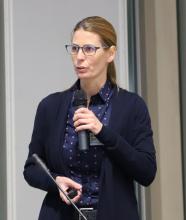 WP3: FeedUtiliGene software to demonstrate modelling of biological functions (Veronika Halas, Kaposvár University)
WP3: FeedUtiliGene software to demonstrate modelling of biological functions (Veronika Halas, Kaposvár University)
FeedUtiliGene is a free software tool that includes 6 modules:
- The digestion module represents the transit and digestion to better understand digestive mechanisms.
- The parameter estimation module adjusts the model parameters and fits the model outputs to body weight and feed intake data.
- The nutrient partitioning module simulates growth performance, body composition, energy and amino acid partitioning and nitrogen and phosphorus excretion, and estimates digestible amino acid and P requirement.
- The fatty acid module estimates the fatty acid composition of the pig as affected by the level and source of dietary fat.
- The robustness module quantifies the robustness of the animal response in terms of resistance and resilience. It detects perturbations and characterizes the animal response.
- The stochastic module addresses variation among individuals, which may originate from differences in nutrient partitioning. The module generates a population of animals with consideration of plausible individual variance.
FeedUtiliGene can be used in education and extension services. It provides easy access to models developed in the project and published in peer-reviewed publications. The tool is useful for nutritionists and geneticists, and it provides insight on feed-use mechanisms and animal variation.
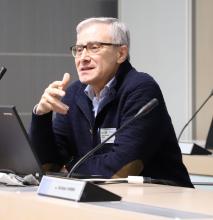 WP4: Innovative feeding technologies to improve feed efficiency and reduce the environmental impact (Jesús Pomar, Universitat de Lleida)
WP4: Innovative feeding technologies to improve feed efficiency and reduce the environmental impact (Jesús Pomar, Universitat de Lleida)
A common architecture has been proposed and designed to build precision feeding systems for growing pigs, sows and poultry, based in the development of 3 main components:
- Feeder devices adapted to each species or physiological state.
- Decision support system (DSS) to estimate the nutritional requirements from measured and collected data on animals. DSS have been developed for precision feeding application and adapted to pigs, sows, broilers and laying hens.
- A controlling module that integrates multiple hardware and software components.
Two pre-industrial precision feeding systems (PFS) prototypes for growing pigs have been build for demonstration and validation purposes:
- A PFS including 4 precision feeders has been installed and is operational in a commercial pig farm in the Parma region (Italy)
- A PFS including 5 precision feeders is running at the IFIP research station at Romillé (France).
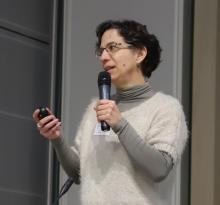 WP5: New traits and models for animal selection (Hélène Gilbert, INRAE)
WP5: New traits and models for animal selection (Hélène Gilbert, INRAE)
The dual challenge was to increase the accuracy of breeding values via cheaper/easier measurements, and to make animals more feed-efficient when breeding conditions vary.
New traits for feed efficiency that were investigated include:
- Direct measures of feed intake in broilers and rabbits.
- Molecular indicators of feed efficiency (genomic markers of residual feed intake, selection on blood serum colour in poultry, genomic markers of growth rate in rabbits).
- Measures of components of feed efficiency that include behaviour/aggressiveness, welfare/robustness, and digestibility (in pigs).
- New traits derived from the microbiota have been studied in rabbits.
New statistical models have been developed. They include models that improve response on feed efficiency, models that account for indirect genetic effects on feed efficiency, and models that account for the individual’s environmental sensitivity. Methods for using crossbred (genomic) information have been developed.
The most promising results are:
- Individual feeders in broilers and rabbits
- Group records in pigs, which may help to increase the genetic gain at a little cost
- Indicators of feed efficiency: including digestibility measurements, microbiota and biomarkers. These indicators must still be validated.
- Recommendations to use the best indicators and genomic and crossbred information.
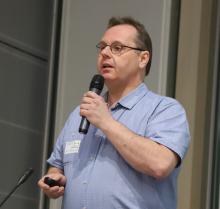 WP6 - Evaluating the sustainability of new approaches to livestock feeding (Guy Garrod, Newcastle University)
WP6 - Evaluating the sustainability of new approaches to livestock feeding (Guy Garrod, Newcastle University)
Life cycle analysis was used to analyse the environmental impacts of novel European protein sources and precision feeding.
- Novel protein sources were found to have the potential to reduce climate change impact and energy consumption.
- Precision feeding can reduce nitrogen excretion in pigs, which has benefits for acidification and eutrophication. For broilers, precision feeding resulted in small improvements.
Cost-benefit analysis of the same innovations gave the following results:
- For pigs, farm net income (FNI) increased with the use of improved rapeseed meal, green protein, ad libitum precision feeding, or with improved traits.
- For broilers, FNI increased slightly with the use of novel soybean meals. Green protein had a negative impact.
Consumer attitudes were studied in the UK and Spain focusing on egg production:
- Consumers were willing to pay more for eggs produced with lower emissions and water use.
- Welfare and food safety were more important to consumers than prices or environmental impacts; there is a trade-off between animal welfare and environmental benefits.
- Improved feeding methods, use of animals with higher feed conversion rates, and use of novel feeds were all found to be acceptable to most consumers.
Farmers were interviewed in the UK and Spain about Feed-a-Gene innovations:
- Industry respondents were enthusiastic about precision feeding’s potential to improve feed conversion efficiency and profits. There were questions about equipment reliability, costs of adoption, and savings from reduced feed use.
- Farmers were generally positive about using animal feeds incorporating green protein. They had reservations about European-grown rapeseed and soybean meal, though European soybean was seen as a GM-free alternative to imported soybean meal.
Simple composite indices have been developed to allow a comparison of the sustainability implications of different production scenarios (see the Sustainability appraisal workshop on the next page for more information on these results).
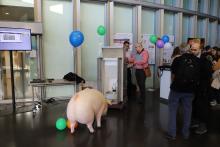
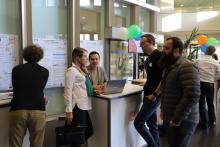 Discoffeery session
Discoffeery session
This session was dedicated to demonstration activities
Five demonstration areas that included booths, feeding equipment, computers, video screens and posters were set up in the lobby of the Hôtel de Rennes Métropole. A special session of 1h30 called “Discoffeery” took place on 22 January, during which Feed-a-Gene partners were present in each booth to present and discuss the results with the participants. The demonstration areas were accessible during the entire meeting.
- European protein autonomy: samples of novel feeds, 4 laptop presentations of processes and 6 posters.
- New traits and breeding schemes: rabbit cage with an individual feeder, 5 laptop presentations, 6 videos and 11 posters.
- Modelling biological functions: 5 laptop presentations about the models, 1 video and 6 posters.
- Precision feeding: precision feeding system (feeder, software and hardware), 3 videos and 5 posters.
- Sustainability assessment: 7 posters .
Sustainability appraisal workshop
This workshop consisted in a discussion on sustainability appraisal where all participants were able to share their vision of the sustainability and future of monogastric livestock production systems.
The presentation that framed the sustainability appraisal workshop was based around the proposition that the production of feed for livestock is an important contributor to the negative impacts that farming systems may have on the environment. It was then argued that changing animal feeding systems is an important approach to reducing these negative impacts. The challenge for the Feed-a-Gene project was to investigate the sustainability of the novel feeding systems proposed by the project to determine the extent to which they improve on the status quo.
The discussion took place within the context of the United Nations’ Sustainable Development Goals.
- SDG2 Zero Hunger: monogastric livestock production still has an important role to play where animal products are a favoured or the most accessible source of protein.
- SDG9 Industry, Innovation and Infrastructure: Feed-a-Gene developed innovations that improve the efficiency of monogastric livestock production while making it more sustainable. These technologies are meant to be turned into commercially-viable products.
- SDG12 Responsible Consumption and Production: the project contributes to responsible production and promotes practices that meet the approval of consumers. As consumers seem to be more concerned by livestock welfare than by the environmental impacts of livestock production, there is a need to address possible trade-offs between livestock sustainability and animal welfare.
- SDG13 Climate Action and SDG15 Life on Land: the project’s objective of reducing European reliance on Brazilian soybeans is consistent with these goals.
Participants were comfortable with the use of sustainability indicators for assessing the sustainability of feeding systems. However, some were concerned by the availability of the economic, environmental and social data that are required to implement this approach for assessing novel alternatives in the future. For that reason, the development of new technologies should be accompanied by a similar process of data collection and analysis as that implemented in the Feed-a-Gene project.
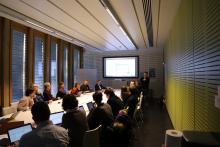 From results to innovation
From results to innovation
Four thematic workshops were dedicated to the applicability and exploitation of Feed-a-Gene results. The objective of the workshops was to produce SWOT analyses,– Strengths, Weaknesses, Opportunities, Threats – to help stakeholders to transform the outputs of Feed-a-Gene into products that are economically and environmentally sustainable, and socially acceptable.
New feeds and processes and nutrition: protein supply, nutritive value assessment
Soybean is a very good ingredient that is hard to beat: novel feeds should be complementary rather than whole substitutes. For novel feeds, the questions of nutritional quality, variability, availability, costs, and consumer acceptance should be considered.
Big data and modelling
The models and tools developed in Feed-a-Gene provide opportunities for characterisation and prediction, and take advantage of "big data" availability. While they are useful for academic purposes (research and higher education), their value for farmers and industrial stakeholders needs to be validated.
Genetics and breeding: new traits/bioindicators and breeding schemes
The Feed-a-Gene geneticists have provided results on how to improve feed efficiency. Still, there is a need to broaden the focus, by including other aspects of livestock production such as alternative feeds, or even by looking at other directions, including sustainability and social demands.
Novel feeding technologies: precision feeding
Livestock precision farming has a lot to offer in terms of improved efficiency - technical, economic and environmental -, with a potentially positive effect on social acceptance. It still needs to be validated in terms of ROI, complexity, and image if communication about it is too technology-centred.
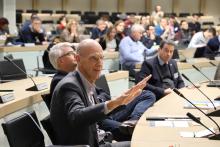 Final discussion: Which future for livestock production?
Final discussion: Which future for livestock production?
The final session was a round table where the speakers of the past two days exchanged ideas with stakeholders in the audience.
The main issue discussed in the round table was communication. Stakeholders are concerned that the future of livestock production is being threatened by a growing disconnect between the general public and livestock farming, fuelled by a lack of knowledge about agriculture and by the dissemination of misleading information. They agree that communication towards the general public is key to fight this trend. This communication should be structured and involve the industry, scientists and policy makers. It should be handled by communication specialists and organizations such as NGOs that have their own channels, though everyone in the sector should play their part. Communication should target the general public, starting in primary schools, and it should use the same tools as those used by critics of livestock farming, particularly social media. The message should use accessible language, as well as facts and figures to emphasize the values and positive impacts brought by livestock farming, making it part of the solution rather than a problem. It should be very open, highlighting the changes without ignoring the past. Finally, it was recommended that future projects involve members of the civil society, such as NGOs, and include in the project, from the very start, the questions raised by these stakeholders.
Another issue discussed in the final session was the tension between global and local sustainability: are solutions that are sustainable at local level still sustainable at global level? There is also a tension between animal welfare goals (much favoured by the general public) and environmental goals, and scientists should play a role in highlighting some of the necessary trade-offs. Other issues discussed were the decreasing European leadership and the lack of level playing field between European standards of production and trade agreements allowing imports of products that do not comply with those standards.
.

